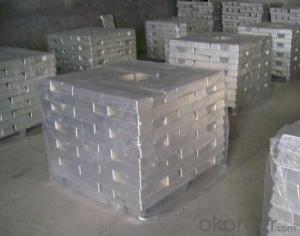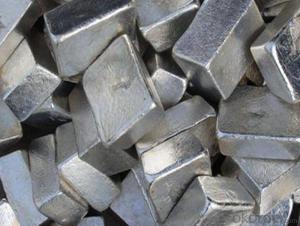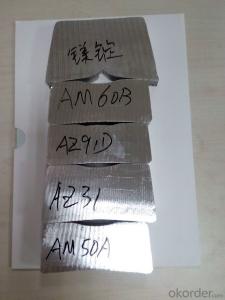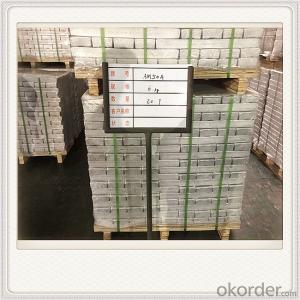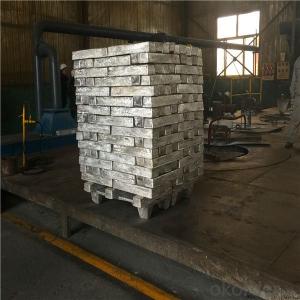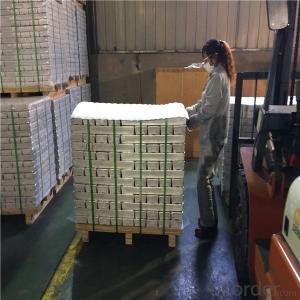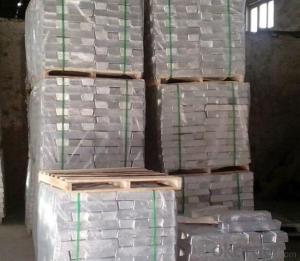Mg9997 Magnesium Alloy Ingot Plate Good Quality Ingot
- Loading Port:
- Tianjin
- Payment Terms:
- TT OR LC
- Min Order Qty:
- 2 m.t.
- Supply Capability:
- 6000 m.t./month
OKorder Service Pledge
OKorder Financial Service
You Might Also Like
Product Description:
1. Specification:The Mg Metal is a fairly strong, silvery-white, light-weight metal.
Form: ingot
ingot: (8 ± 0.5) kg / ingot
Specifications: (50-55)cm×(11.5-13.5)cm×(7-7.5)cm
2. Application:
1. The high temperature at which magnesium burns makes it a useful tool for starting emergency fires during outdoor recreation. Other related uses include flashlight photography, flares, pyrotechnics and fireworks sparklers.
2. To photoengrave plates in the printing industry.
3. In the form of turnings or ribbons, to prepare Grignard reagents, which are useful in organic synthesis.
4. As an additive agent in conventional propellants and the production of nodular graphite in cast iron.
5. As a reducing agent for the production of uranium and other metals from their salts.
6. As a sacrificial (galvanic) anode to protect underground tanks, pipelines, buried structures, and water heaters.
3. Mg Alloys Metal (Ingot)

4. Advantages:
Good Quality ............... The most important factor we care.
Competitive Price ........ For our mutual benefit.
Prompt delivery ........... Abundant production ability, storage ability and manpower.
Excellent Service ......... Customer always first.
Now our main markets in Asia and Europe, to the future we will set up sales network in more than 200 countries around the world.
Image






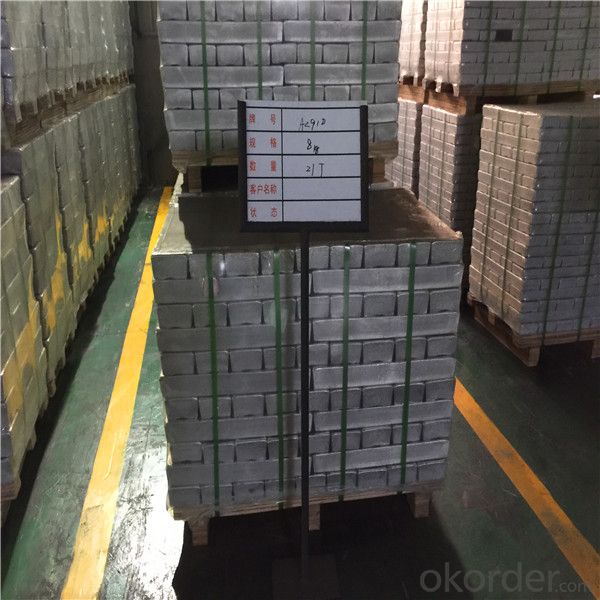
What is Magnesium Alloys?
Magnesium alloys are mixtures of magnesium with other metals (called an alloy), often aluminum, zinc, manganese, silicon, copper, rare earths and zirconium. Magnesium is the lightest structural metal. Magnesium alloys have a hexagonal lattice structure, which affects the fundamental properties of these alloys. Plastic deformation of the hexagonal lattice is more complicated than in cubic latticed metals like aluminium, copper and steel; therefore, magnesium alloys are typically used as cast alloys, but research of wrought alloys has been more extensive since 2003. Cast magnesium alloys are used for many components of modern automobiles, and magnesium block engines have been used in some high-performance vehicles; die-cast magnesium is also used for camera bodies and components in lenses.
Practically, all the commercial magnesium alloys manufactured in the United States contain aluminum (3 to 13 percent) and manganese (0.1 to 0.4 percent). Many also contain zinc (0.5 to 3 percent) and some are hardenable by heat treatment. All the alloys may be used for more than one product form, but alloys AZ63 and AZ92 are most used for sand castings, AZ91 for die castings, and AZ92 generally employed for permanent mold castings (while AZ63 and A10 are sometimes also used in the latter application as well). For forgings, AZ61 is most used, and here alloy M1 is employed where low strength is required and AZ80 for highest strength. For extrusions, a wide range of shapes, bars, and tubes are made from M1 alloy where low strength suffices or where welding to M1 castings is planned. Alloys AZ31, AZ61 and AZ80 are employed for extrusions in the order named, where increase in strength justifies their increased relative costs.
Magnesium L-threonate is used as a dietary magnesium supplement
Overdose from dietary sources alone is unlikely because excess magnesium in the blood is promptly filtered by the kidneys. Overdose with magnesium tablets is possible in the presence of impaired renal function. There is a single case report of hypermagnesemia in a woman with normal renal function using high doses of magnesium salts for catharsis. The most common symptoms of overdose are nausea, vomiting and diarrhea; other symptoms include hypotension, confusion, slowed heart and respiratory rate, deficiencies of other minerals, coma, cardiac arrhythmia, and death from cardiac arrest.
Plants require magnesium to synthesize chlorophyll, essential for photosynthesis. Magnesium in the center of the porphyrin ring in chlorophyll functions in a manner similar to the iron in the center of the porphyrin ring in heme. Magnesium deficiency in plants causes late-season yellowing between leaf veins, especially in older leaves, and can be corrected by applying to the soil either Epsom salts (which is rapidly leached), or crushed dolomitic limestone.
5.FAQ
We have organized several common questions for our clients,may help you sincerely:
①How about your company?
CNBM, The Fortune 500. A world class manufacturer & supplier of magnesium alloys ingots plates&sheets, magnesium alloy bars, Magnesium alloy slabs,magnesium alloy wires,magnesium alloy tubes and etc.. bases in China.
②How to guarantee the quality of the products?
We have established the international advanced quality management system,every link from raw material to final product we have strict quality test;
We would like to offer free samples for your inspect and check.
We have advanced manufactured equipments,such as hot rolling equipment. We resolutely put an end to unqualified products flowing into the market. At the same time, we will provide necessary follow-up service assurance.
③What is your main markets?
Our main markets are from Europ, America and Aisa. Such as Germany,Czech, Poland, England, Canada, Korea, Turkey etc.
- Q: Causes of high manganese content in magnesium ingot
- Magnesium in the air in the combustion reaction of oxygen, magnesium and Magnesium Oxide in the air, and the quality of the quality of the resulting Magnesium Oxide equal in response to magnesium and oxygen quality, so the quality of the product than the quality of the original magnesium increases.
- Q: What is the black powder on the surface of magnesium ingot AM50A?
- AZ91D, the most widely used magnesium alloy, has high strength and excellent casting performance. It is used in motorcycles, computer parts, housings, and lids
- Q: What are the surface defects of magnesium alloy rolling?
- General magnesium alloys will not be rolled, so that the rolled products are easy to oxidize and not conducive to preservation
- Q: What harm does magnesium alloy have to human body?
- Yes, the alloy is usually aluminum, magnesium, iron and the like, may cause chronic aluminum poisoning, that is, excessive accumulation of aluminum in the body, affecting intelligence and other physical functions.
- Q: What are the generally feasible surface treatment methods for magnesium alloy die castings?
- Your question is difficult to answer, the general casting magnesium alloy surface treatment should be divided into surface coating treatment and surface treatment, although the two are related, but in the process and technology, but there is a big difference, its main features are not the same. Therefore, you must specify the purpose and function of your work before you can tell you the actual surface treatment.
- Q: Why the cost of ferrosilicon production will lead to a rebound in the price of magnesium ingot?
- 75# ferrosilicon in pidgeonmagnesiumprocess often used in high temperature smelting process of magnesium metal, will be replaced from CaO.MgO mg, each ton of magnesium will consume 1.2 tons of ferrosilicon, plays a big role in magnesium production.
- Q: The industrial application of magnesium and the main title and technical difficulty of producing magnesium products with magnesium chloride as raw material
- 1, unit investment is low.2, the production cost is low. As a result of magnesium ore, coal and other phasesThe prices of the raw materials are lower, the labor and management costs are not high, so the totalLower production costs.3, magnesium and related resources are rich. China is the richest country in magnesium resourcesOne of。 The total reserves of magnesite are 2 billion 700 million T, dolomite mine about 4000000000 T, and QinghaiThe potassium and magnesium salt and coastal brine magnesium reserves are very large.
- Q: What are the differences between aluminium magnesium alloy, aluminum alloy and plastic steel?
- An alloy based on aluminum. The main alloying elements are copper, silicon, magnesium, zinc and manganese. The minor alloying elements are nickel, iron, titanium, chromium, lithium and so onAluminum alloy low density, but relatively high strength, close to or higher quality steel, plastic good, can be processed into various profiles, with excellent conductivity, thermal conductivity and corrosion resistance, widely used in industry, the use of only steelAluminum Alloy divided into two categories: cast Aluminum Alloy, cast under; deformation Aluminum Alloy, can withstand the pressure processing, mechanical properties than cast. Aluminum Alloy material can be processed into various forms and specifications. Mainly used in the manufacture of aviation equipment, daily necessities, building doors and windows.
- Q: Will the enterprises that produce sponge titanium use magnesium ingots?
- Can be used, or can not be, according to process methods and the production of sponge too, one way is to use magnesium reduction method
- Q: What is magnesium aluminum alloy and what is its use?
- Magnesium ingot and aluminium in the above 1150K, reaction of aluminum and oxygen in the air to form a-Al2O3, the crystal chemical properties of alumina is inert, a barrier and isolation. Less than 1150K, in the B-Al2O3 and the crystal reaction with acid magnesium alloy not inner protection.
Send your message to us
Mg9997 Magnesium Alloy Ingot Plate Good Quality Ingot
- Loading Port:
- Tianjin
- Payment Terms:
- TT OR LC
- Min Order Qty:
- 2 m.t.
- Supply Capability:
- 6000 m.t./month
OKorder Service Pledge
OKorder Financial Service
Similar products
Hot products
Hot Searches
Related keywords















